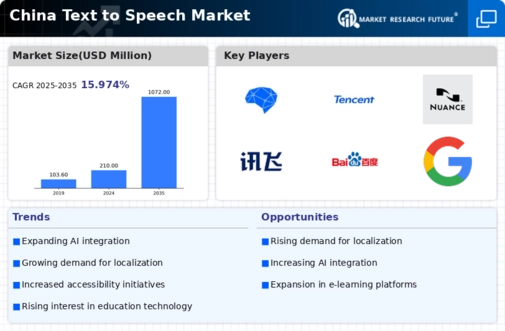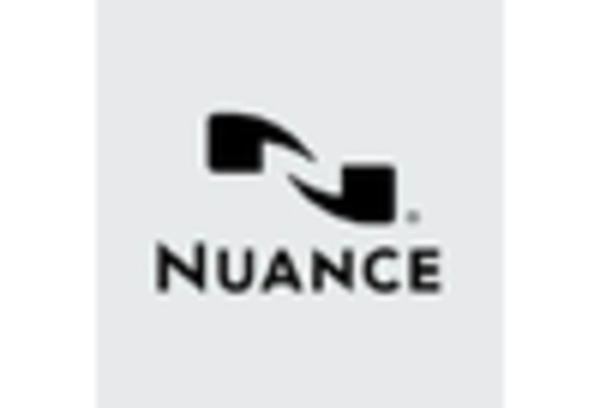Growth of the E-Learning Sector
The expansion of the e-learning sector in China is significantly impacting the text to-speech market. With the increasing reliance on online education platforms, there is a growing need for tools that facilitate learning through auditory means. Text to-speech technology enhances the learning experience by providing audio support for written content, which is particularly beneficial for language learners and those with reading difficulties. In 2025, the e-learning market is expected to reach $100 billion, with a notable portion of this growth attributed to the integration of text to-speech features. Consequently, the text to-speech market industry is poised to capitalize on this trend, as educational institutions seek to adopt innovative solutions to enhance student engagement.
Rising Demand for Voice Assistants
The increasing adoption of voice assistants in various applications is driving the text to-speech market in China. As consumers become more accustomed to interacting with technology through voice commands, the demand for natural-sounding speech synthesis is surging. In 2025, the market for voice assistants is projected to grow by approximately 30%, indicating a robust interest in enhancing user experience through voice technology. This trend is particularly evident in smart home devices, mobile applications, and customer service platforms, where text to-speech capabilities are essential for seamless interaction. The text to-speech market industry is thus positioned to benefit significantly from this rising demand, as companies strive to integrate advanced speech synthesis into their products.
Increased Investment in Smart Technologies
The surge in investment in smart technologies is influencing the text to-speech market in China. As businesses and consumers alike embrace smart devices, the integration of text to-speech capabilities becomes increasingly vital. In 2025, investments in smart home technologies are projected to exceed $50 billion, with a significant portion allocated to enhancing user interfaces through voice interaction. This trend is indicative of a broader shift towards automation and convenience, where text to-speech solutions play a critical role in facilitating communication between users and devices. The text to-speech market industry stands to gain from this influx of investment, as companies strive to innovate and meet the evolving demands of tech-savvy consumers.
Government Initiatives for Digital Inclusion
The Chinese government is actively promoting digital inclusion, which is fostering growth in the text to-speech market. Initiatives aimed at enhancing accessibility for individuals with disabilities are particularly noteworthy. For instance, the government has allocated substantial funding to develop assistive technologies, including text to-speech solutions, to ensure that all citizens can access digital content. This commitment is reflected in the 20% increase in funding for accessibility projects in 2025. As a result, the text to-speech market industry is likely to see a surge in demand from educational institutions and public services seeking to comply with these regulations and improve accessibility for all.
Technological Advancements in Speech Synthesis
Technological advancements in speech synthesis are propelling the text to-speech market forward. Innovations in artificial intelligence and machine learning are enabling the development of more natural and expressive speech outputs. In 2025, the market is anticipated to witness a 25% increase in the adoption of neural network-based text to-speech systems, which offer superior voice quality and intonation. This evolution is crucial for applications in entertainment, gaming, and virtual reality, where immersive experiences are paramount. The text to-speech market industry is thus likely to experience heightened interest from developers seeking to leverage these advancements to create more engaging and realistic audio experiences.

















Leave a Comment